The F-Market & Wharves line is the most successful vintage rail line ever opened. With 20,000+ riders per day, it is on a par with the National Historic Landmark St. Charles streetcar line in New Orleans, which has been in service continuously as a rail line since 1835, and as an electric streetcar line since the 1890s.
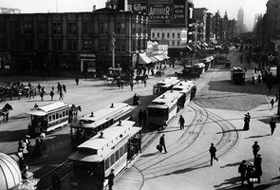 San Francisco Municipal Railway photo.
San Francisco Municipal Railway photo.
The F-line, by contrast, is a very recent phenomenon. But, while it first opened in 1995, its roots are nearly as deep as the St. Charles line.
San Francisco’s main boulevard, Market Street, has had nearly continuous rail transit service since 1860.
Steam trains, then horse cars, then cable cars provided passenger service on Market Street until the morning of April 18, 1906, when the great earthquake and fire devastated the system. When the city rebuilt, it was largely with electric streetcars.
The privately-owned United Railroads installed multiple streetcar lines that provided service the length of Market. Several of these, the 5, 6, 7, and 21 lines, still exist today as bus routes.
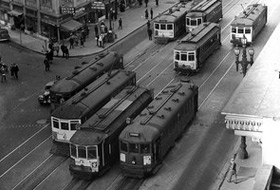 San Francisco Municipal Railway photo.
San Francisco Municipal Railway photo.
On December 28, 1912, the Municipal Railway was born, government-owned (a novelty at the time), and a reaction to the sometimes corrupt practices of private transit companies.
Within a few years, Muni had laid down its own set of tracks on Market Street, flanking the United Railroads tracks, to compete with that private company (which in 1921 was reorganized as the Market Street Railway Co., from which our unrelated nonprofit group takes its name).
San Franciscans of a certain age still fondly remember what was called the Roar of the Four, a quartet of streetcar tracks side by side from the Ferry Building all the way to Castro Street, where Market Street Railway Co.’s 8-line turned south and terminated, while Muni’s K, L, and M lines plunged into the City-built Twin Peaks Tunnel.
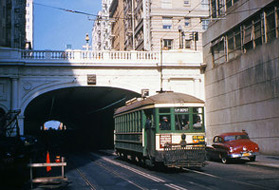 San Francisco’s original F-line, the F-Stockton for which the Stockton Tunnel was built. Bob McVay photo, Walter Rice collection.
San Francisco’s original F-line, the F-Stockton for which the Stockton Tunnel was built. Bob McVay photo, Walter Rice collection.Muni had several additional streetcar lines in addition to the ones on Market.
There was the E-Union, which ran north from the Ferry Building for a few blocks on The Embarcadero, then headed west through the now-vanished produce district, up Columbus through North Beach, then over Russian Hill on Union and other streets to reach the Presidio.
And there was the F-Stockton, which started at Market Street, headed north on Stockton past Union Square, through the Stockton tunnel, built primarily for streetcars, then through North Beach and the Marina District. But after Muni took over the Market Street Railway Co. in 1944, streetcar lines quickly vanished by the dozens, including these two replaced by trolley buses (the 41-line replacing the E, the 30-line replacing the F).
The Fall and Rise of Market Street
Most US cities abandoned their streetcar systems altogether in this time period, but Muni kept the tunnel lines (K, L, M, N) and the J-Church.
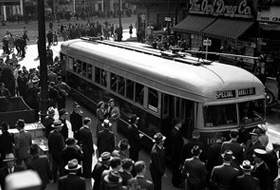 San Francisco Municipal Railway photo.
San Francisco Municipal Railway photo.By 1958, Muni’s original streetcar fleet had been retired, replaced with 105 streamlined PCC type cars (the art deco cars most often seen on the F-line today). These continued to run on the surface of Market Street, by this time reduced to two tracks.
The passage of a huge bond issue in 1962 to build the regional BART rail system also included money to upgrade Muni’s streetcar lines by providing a second subway level above the BART tracks, under Market Street. By the early 1980s, this subway was completed and linked to the old Twin Peaks Tunnel at Castro Street. New streetcars — now given the fancy name of light rail vehicles (LRVs) — were bought from Boeing. Market Street itself was rebuilt with the idea that the streetcar tracks would soon be removed. In the fall of 1982, the last PCC streetcars ran on Market…or so it was thought.
Return of the Streetcar
Some San Franciscans wanted to retain surface streetcar service on Market. Others envisioned streetcar service the length of The Embarcadero, something that had never been practical while the busy State Belt Railroad, with spurs to every pier, dominated that roadway. Indeed, in 1979 Muni had first proposed an E-Embarcadero line, and in 1980, an F-Market line to replace the 8-Market trolley bus line between the Ferry Building and Castro Street.
Some derided these proposals, saying old streetcars weren’t reliable, couldn’t be maintained, and wouldn’t attract riders. It’s fair to say they were only gaining limited traction by 1982.
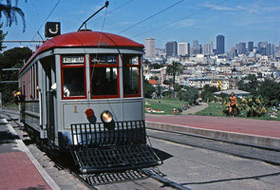 Bob McVay photo, Walter Rice collection.
Bob McVay photo, Walter Rice collection.But then an idea emerged from the transportation committee of the San Francisco Chamber of Commerce.
Coincidentally, the city’s famed cable car system was being shut down in the fall of 1982 for a desperately-needed complete rebuilding. Cable cars would be off the streets for eighteen months.
The visitor industry was worried that tourists would stay away. The committee chair, Rick Laubscher, a journalist turned public relations executive, noticed that to celebrate the end of streetcar service on the surface of Market, Muni had rolled out its very first streetcar — car No. 1, built in 1912 — and leased another retired car, No. 178, from a museum. These two cars were running on Market for several weekends.
What if more such streetcars could be gathered from other sources so that more frequent, visible service could be provided, on weekdays as well? Could this be promoted as a substitute historic rail attraction to visitors while the cable car system was under repair?
The Chamber’s leadership embraced the idea, as did Mayor Dianne Feinstein. Muni staff moved to prepare necessary facilities, while Laubscher and other volunteers, including longtime streetcar advocate Maurice Klebolt, worked to lease or otherwise acquire additional streetcars.
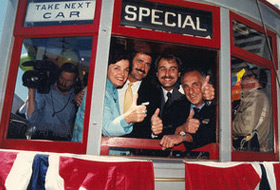 Market Street Railway photo.
Market Street Railway photo.In June, 1983, the San Francisco Historic Trolley Festival opened, running on the old surface streetcar tracks. The route went from the Transbay Terminal at First & Mission Streets to Market, then up Market to Duboce Avenue. From there, it followed a ‘temporary’ streetcar detour built in the 1970s to bypass subway construction under Market: Duboce, Church Street, and 17th Street to Castro. An improvised outdoor maintenance and storage area for the historic streetcars was constructed on the Duboce Avenue right-of-way between Market and Church (now the site of Market Street Railway’s Pharr Division restoration yard).
The Trolley Festival did draw railfans and other visitors to San Francisco, but its greatest success was with San Franciscans themselves.
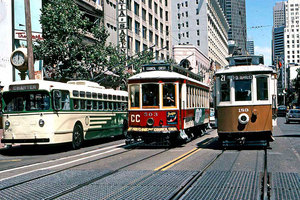 Walter Rice collection.
Walter Rice collection.Many regular Muni riders in the Castro and Upper Market Districts soon began using the historic streetcars instead of the new Muni Metro or surface bus routes. Quite a few automobile commuters switched to the streetcars as well. Part of the attractiveness of the Festival service is that you never knew what might come along next: a bouncy single-truck streetcar from Portugal; a smooth-riding tram from Australia; a Muni original from the 1910s; even an open-topped Boat Tram from Blackpool, England, complete with a skull and crossbones flag on the trolley rope. People just plain loved it.
So much so that when the Festival ended in October, there was a clamor to do it again the following summer (though it had only been intended as a one-year event) — in fact, with the Democratic National Convention coming to San Francisco in 1984, Mayor Feinstein insisted. So the sponsors and volunteers geared up and did it again…and again, and again, and again…five summers in all.
The Chamber of Commerce, which never intended to get into the streetcar business, asked Laubscher to help find another nonprofit organization to support Muni. A seven-member preservation group called Market Street Railway — founded in 1976 to preserve an old Muni trolley bus — offered to meet that need. That small organization was expanded into a membership organization, and became Muni’s nonprofit preservation partner, with over 1,000 dues-paying members today.
From Festivals to a Permanent F-Market
The growing success of the Trolley Festivals re-energized the proposals for a permanent F-line. The San Francisco Board of Supervisors approved the idea, and planning began to identify funding for the line.
By 1987, all was ready. After that year’s Trolley Festival concluded, Muni methodically began replacing the old Market Street tracks with new ones. They restored tracks to upper Market, creating a continuous ribbon of steel to Castro again.
Knowing that the permanent operation required operation up to twenty hours per day, 365 days per year, they evaluated different types of vintage streetcars to provide the backbone of the F-line fleet. They settled on the easy-to-maintain PCC car, a genuine part of San Francisco’s transit heritage, and already much missed by residents. They restored fourteen such cars acquired second-hand from Philadelphia, plus three of Muni’s own retired double-ended ‘Torpedo’ PCCs.
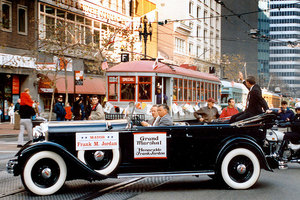 Market Street Railway photo.
Market Street Railway photo.On Friday, September 1, 1995, the F-line opened on Market Street with a big parade of streetcars led by Mayor Frank Jordan. The PCCs were glistening in different paint schemes representing some of the two dozen North American cities that this type of streetcar once served. Immediately, the ridership on the line shot way beyond Muni’s expectation. They scrambled to find additional vintage streetcars to meet demand, and acquired ten Peter Witt-style trams just being retired in Milan, Italy, built in the 1920s but meticulously maintained and renovated.
But this was only the beginning. Plans and funding were nearing completion to extend the line to the foot of Market, then north past the Ferry Building to reach the popular Fisherman’s Wharf area via the northern portion of the earlier proposed E-line. This would provide an alternate historic transit route between Downtown and the Wharf area, complementing the venerable Powell Street cable car lines. Visitors could take a cable car in one direction, a streetcar in the other, avoiding a second long cable car line. The backers of The Embarcadero extension, led by Market Street Railway, referred to the F-line/cable car combination as the Iron Triangle. Today, we refer to the combined system as the Museums in Motion.
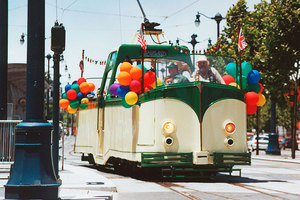 Market Street Railway photo.
Market Street Railway photo.In March 2000, the F-line extension to Fisherman’s Wharf opened amid much fanfare. The streetcars swarmed with riders. Muni had rolled out every operational historic car for the opening parade, but did not intend to put them into regular passenger service. The PCCs and Milan trams were thought to be sufficient to meet demand. The very first day, though, Muni realized what a hit they had on their hands. The historic cars were pressed into service as Embarcadero shuttles from the Ferry Building to the Wharf. These soon became regularly scheduled runs.
History in the future
Historic streetcar service has now been extended farther along San Francisco’s waterfront with the opening of the E-Embarcadero line from Caltrain to the Wharf, sharing track with the F-line to the north and the Muni Metro south of Folsom Street. The E-line is a direct result of Market Street Railway’s advocacy.
There is strong community support, led in part by Market Street Railway, to extend this line west from the Wharf to Fort Mason, a big center for nonprofit organizations and events. Market Street Railway also advocates extending the E-line southward from Caltrain through the fast-growing Mission Bay and Dogpatch neighborhoods, sharing existing tracks with the light rail T-Third line. Market Street Railway has helped to acquire dozens of restorable streetcars for these future extensions.
It’s all due to the huge success of the F-line and the Trolley Festivals that sparked the historic streetcar movement in San Francisco. It’s a history that does the city proud.
None of this would be possible without the financial support of Market Street Railway member. Please consider becoming a member to support historic streetcar service in San Francisco.